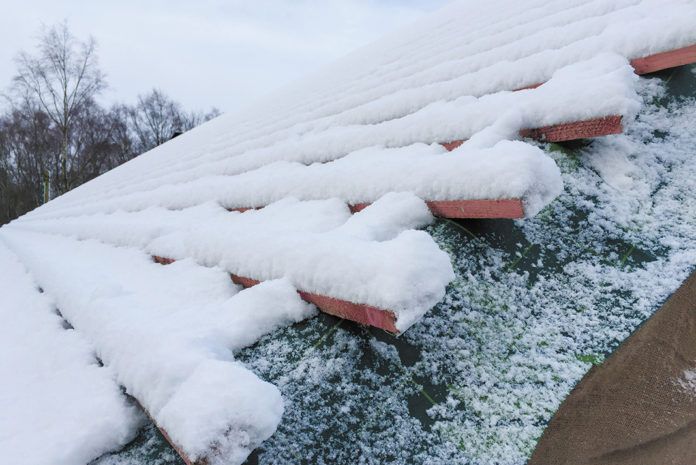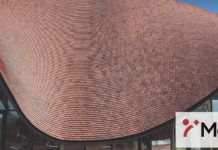When the ‘Beast from the East’ brought weeks of snow in February and March this year, it gave an icy reminder of the devastating effect that strong winds and snow can have on UK homes. As well as rocketing insurance claims for storm and flood damage, the unusually high volume of snow was also a test for pitched roofs. Despite stricter roofing standards, there were still reports of newbuild homes experiencing leaks, where fine powdery snow had come through tile vents and ridge rolls into the roof insulation and down through the ceiling.
Now forecasters are warning of an even worse winter in 2018/19, with even more snow predicted this year, so roofing contractors need to make sure that the dry fix systems they are installing now are robust enough to withstand harsh storms and excessive snow. Roof security is critical to prevent damage to property or injury in high winds, rain and snow.
Just as concerning is the safety of people working on construction sites during the winter, particularly for occupations working at height, such as roofers. As well as the risks of slips and falls, prolonged exposure to the cold can cause construction workers to suffer more colds, bronchitis, asthma, painful joints and fatigue.
So what safety measures should roofing contractors be taking to protect employees as we head into a harsh winter? And how do they make sure roofs are strong enough to withstand the extreme weather that is forecast?
Protecting workers on site
1: When it comes to working on roofs in winter, don’t take any risks. Monitor the weather forecast so you can anticipate and be prepared for poor weather conditions. Carry out a risk assessment every day to check that it is safe to work and that conditions haven’t changed. Pay particular attention to working at height platforms and do not work on roofs in icy conditions.
2: If windy, HSE recommends that roofers should check wind speeds with a hand held anemometer and refer to the National Federation of Roofing Contractors guidance on maximum wind speeds.
3: Make sure you and your employees are wearing the right personal protective equipment and extra clothing suitable for the job and the weather conditions. This usually involves using several layers of clothing, as well as waterproofs or wind-resistant fabrics where necessary. Also, choose water-resistant footwear, with enhanced slip-resistance or ice grips if required.
Protecting roofs in winter
4: Always install roofs to the BS 5534:2014 standard, as this was revised to help make roofs more secure against extreme weather. This means that:
- All single lap tiles must be mechanically fixed, with a degree of clipping required on most roofs.
- Mortar is no longer deemed sufficient on its own to secure tiles and their associated fittings to a roof, so areas including ridges, hips and verges must be mechanically fixed as well.
- Get a new fixing specification for each project, as this will help to ensure the roof is as wind-resistant as possible.
6: Make sure that any dry fix systems you use that require BS 8612 compliance, meet the requirements or have BBA certification.
7: When you are choosing a ridge roll product, consider the size of the holes or methods used for ventilation. Our ridge roll has been designed with smaller holes to minimise the risk of snow getting through, whilst still meeting the requirements of British Standard BS 5250, ‘Code of practice for the control of condensation in buildings’. Also, choose one with a strong adhesive strip and make sure it is securely stuck down.
8: Choose tile vents that come complete with trays. These fit over the top of any tile vents – this channels water and snow away from the hole in the membrane where the vent goes through. If the trays aren’t used, then any water running down the roof would go straight through the hole where the vent is.
9: If you are using any mortar, the National House Building Council states that it should not be used below 2°C, to resist frost damage.
10: Always install membranes to BS 5534 requirements and seal the laps to prevent snow or water ingress. Our vapour permeable and non-breathable membranes come with integrated tape to seal the laps to prevent ballooning, without the need for additional tapes or the use of a dangerous fly batten.
11: To prevent condensation, don’t use a breathable membrane as the only source of ventilation. The term ‘breathable’ underlay is quite often misunderstood because it suggests that ventilation is not required. However, BS 5250 does not include the option of no ventilation to the roof void. As such, roofs will always require some form of supplementary low and high-level ventilation in accordance with BS 5250.
12: Consider using a full roof system from one manufacturer. This means all of the different components have been designed and tested to work together. In addition, with our roof system, you can benefit from a 15-year warranty, giving you peace of mind if there ever was a homeowner complaint and reducing the inconvenience of repair.
To help you prepare for freezing temperatures, Marley is giving away hundreds of winter goodies. To apply for one of 500 free flasks, heat pads or ear bands, visit www.marley.co.uk/wintercampaign and fill in your details.




